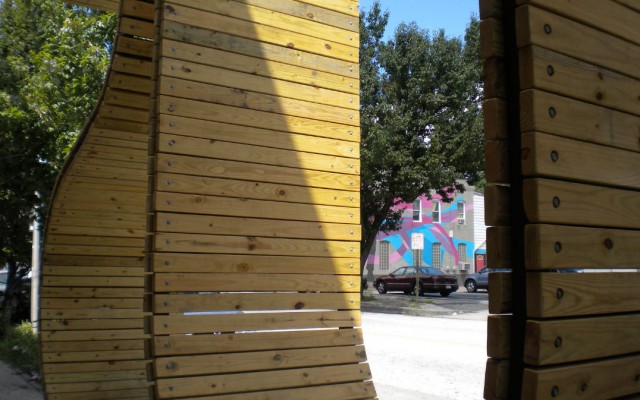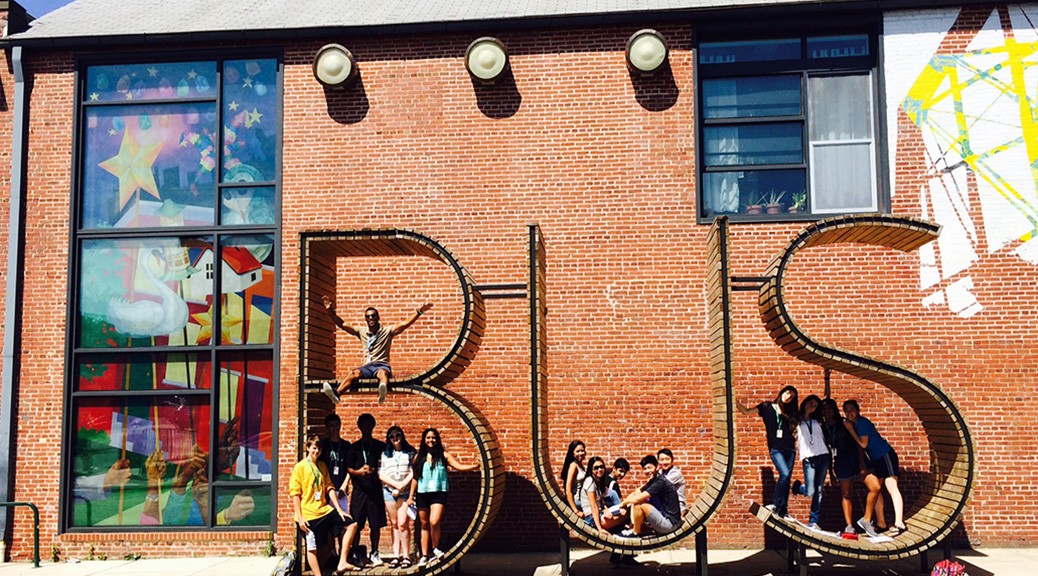“Artists like to explain their work, but this is a piece of work very, very easy to understand,” said Ciro Márquez, describing the new piece next to the Creative Alliance on S. East Ave.
Márquez—who is part of mmmm…—a Madrid-based artist collective that also includes Eva Salmerón, Alberto Alarcón and Emilio Alarcón—was speaking about what the national press has taken to calling “the world’s most obvious bus stop,” a giant, steel-and-wood rendering of the word “BUS.”
For many, the bus stop is a symbol of everyday drudgery—the trip to work—but in quirky Highlandtown, it’s a symbol of fun and interaction. People can recline in the curve of the U, or take shelter from the rain inside the B. Who knows what they’ll do in the S?
Bus stop brainstorms
The point, according to Salmerón, is that the structure “makes you meet the people who are waiting with you.”
“We wanted to make a fun place for waiting; normally the waiting is very annoying,” she said.
Salmerón’s sentiments echo the desires of residents, as revealed through a series of Creative Placemaking workshops.
Kari Snyder, director of neighborhood programs for the Southeast Community Development Corp., which, with Banner Neighborhoods and the Creative Alliance lead a collaborative called Communities for All Ages, aimed at bringing generations together to tackle common community issues. Snyder said that the group started “looking at community gathering places and making them more welcoming and more walkable for people of all ages” about two or three years ago.
The bus stop at Conkling St. and Eastern Ave. (not the home of the new BUS sculpture, but a few blocks away) in particular stood out as an inhospitable, chaotic public space, with no real place to sit—or even stand for that matter.
The discussions of this and a few other places, Snyder said, “was the launch of our Creative Placemaking workshops, and re-imagining what public places could be like, by listening to residents tell us what they wanted them to be like.”

Selecting the right space and the artist collaborators
Workshops were held and gatherings convened, at the Southeast Anchor Library, Creative Alliance and Southeast CDC headquarters. While cities across the U.S. are full of so-called “public places,” Snyder said, the lack of seating, shade, shelter and lighting can paradoxically make them spaces to be avoided.
“They’re really built to keep people out; we wanted to bring people in,” she said.
People in high places apparently agreed, as Baltimore City, with help from Chris Ryer, president of the Southeast CDC, became the recipient of $800,000 in Federal Transit Administration funds, purposed toward improving six Highlandtown bus stops along Eastern Ave.
When it rains, it pours; more or less simultaneously, the Southeast CDC was approached by the Baltimore Office of Promotion and the Arts about a partnership with the European Union. As a result, the Southeast CDC was selected to administer an ArtPlace America Grant, plus funding from EUNIC, an EU organization, dedicated to transforming a public space with public art.
Snyder said that the bus stop in front of the Creative Alliance was chosen, partially because it was not one of the six bus stops—two each at Eastern Avenue’s intersections with S. East Ave., S. Highland Ave. and S. Conkling St.—already slated for improvement with federal money.
“We wanted to partner with the Creative Alliance,” added Snyder. “Also, the sidewalk there is really wide. Plus, we had just completed a Creative Placemaking workshop at the Creative Alliance, and this was a spot we had focused on.”
The next step was choosing the artists, and mmmm…, already famous in the U.S. for their Times Square “Meeting Bowls,” were a great fit.
“We really liked that their art was interactive,” explained Snyder. “They speak Spanish, which is useful here.”
There was another factor.
“They’re a collective—a team,” Snyder said. “We always take a team approach here, so that’s a good match.”
BUS becomes reality
Mmmm….’s first stab at the bus stop was not the perfect match. The quartet came up with a giant, reclining nude for the backdrop of the bus stop. Snyder said that more funding was obtained from the EU to get the collective to Highlandtown, so the artists could get a better sense of the place.
Their next design was a home run.
“Once they came here and experienced Highlandtown, they came up with BUS, which is great,” said Snyder. “Clearly, coming here had a big impact on their design.”
“You get the best projects and events in a neighborhood when you get to know a place and its character, and stay true to that,” she added.
